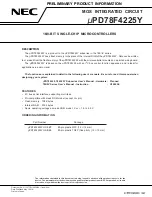
Power PMAC Clipper User Manual
Connections and Software Setup
47
Ch. #
Serial Encoder Data Registers
1
Clipper[0].Chan[0].SerialEncDataA
Clipper[0].Chan[0].SerialEncDataB
2
Clipper[0].Chan[1].SerialEncDataA
Clipper[0].Chan[1].SerialEncDataB
3
Clipper[0].Chan[2].SerialEncDataA
Clipper[0].Chan[2].SerialEncDataB
4
Clipper[0].Chan[3].SerialEncDataA
Clipper[0].Chan[3].SerialEncDataB
With a 37-bit (25-bit single-turn, 12-bit multi-turn) serial encoder, the resulting position data would reside
in the following bit fields:
31
PowerBrick[].Chan[].SerialEncDataA
26
27
28
29
30
0
1
2
3
4
5
6
7
8
9
10
11
12
13
14
15
16
17
18
19
20
21
22
23
24
25
Single-Turn Data
PowerBrick[].Chan[].SerialEncDataB
Multi-Turn Data (cont.)
31
26
27
28
29
30
0
1
2
3
4
5
6
7
8
9
10
11
12
13
14
15
16
17
18
19
20
21
22
23
24
25
Multi-Turn Data
Note
Knowing where the position data resides is essential for the proper
setup functions of the motor/encoder.
Encoder Conversion Table
The Encoder Conversion Table ECT must be set up properly for the Power PMAC to increment the on-
going position of the motor/encoder.
The source data for the ECT is typically serial register data A.
For the ECT, the number of bits of interest is the single-turn protocol resolution. Additionally, the Most
Significant Bit MSB of this data must be positioned at bit #31 so that rollover is handled gracefully. With
the 25-bit Single-Turn encoder, we apply a left shift of 7 bits (32 – Single-Turn data length) and adjust the
scale factor accordingly:
















































